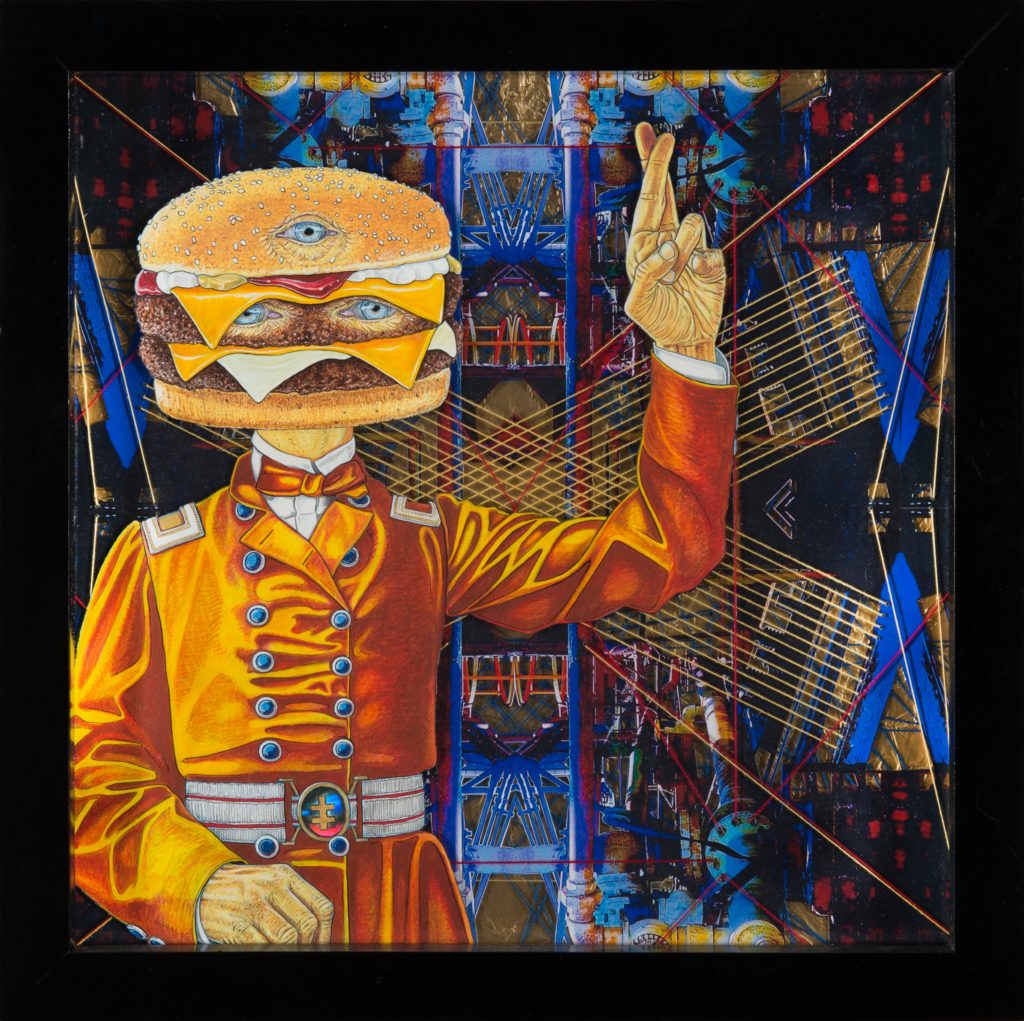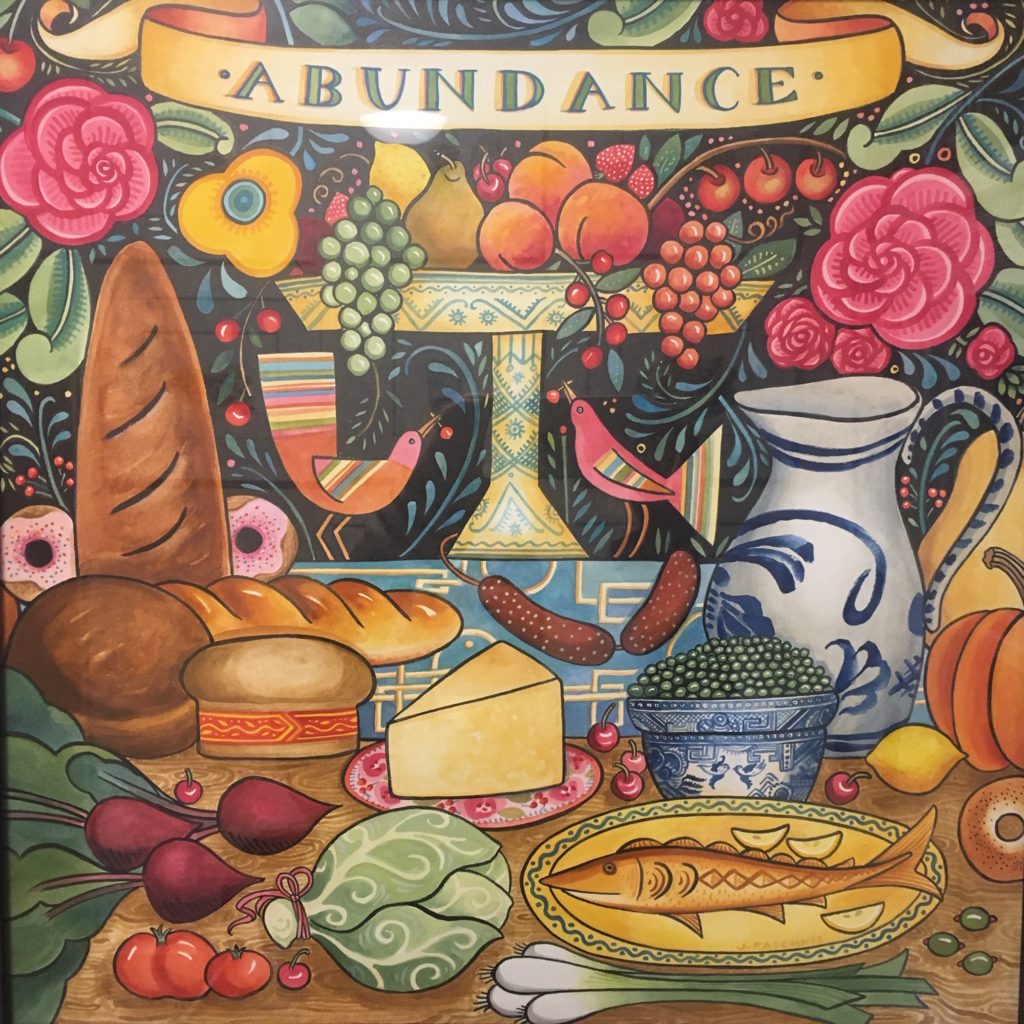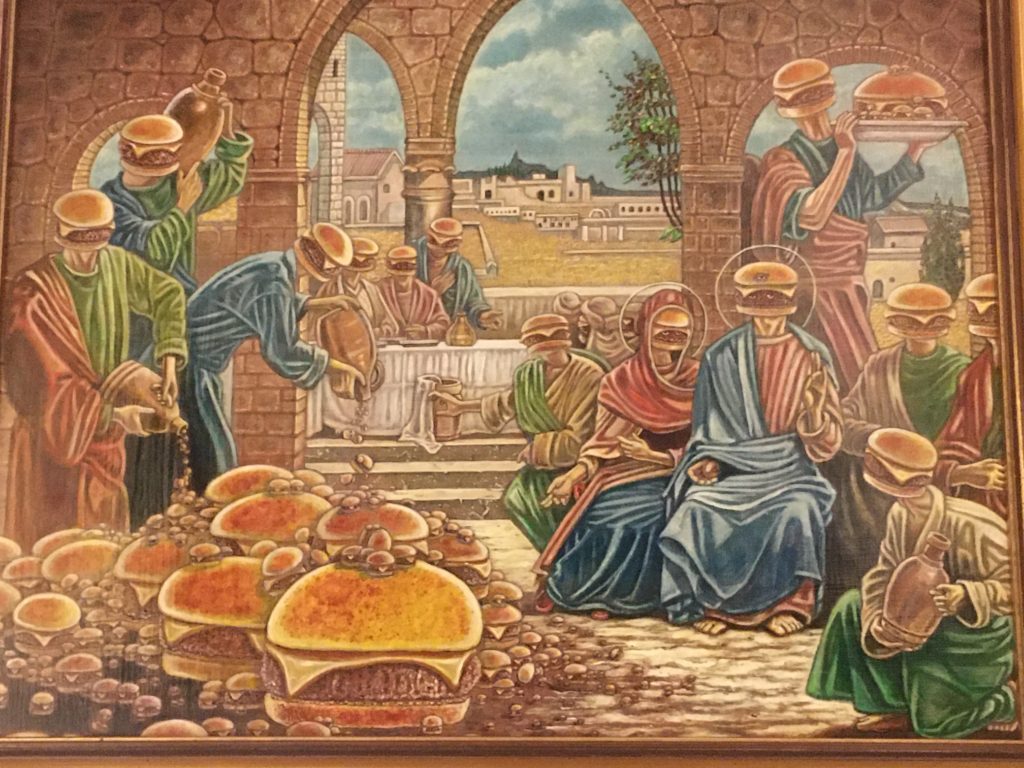Healthy Eating for a Healthy Planet
Save the bees! Eat less meat! Cut the sugar! Grow your own food! Go organic! Go vegan! So many messages… so little time each day. Let’s simplify things shall we?
Each U.S. household produces emissions, and 17% (8 tons of CO2 per year per household) is based on food consumption. Worldwide, livestock agriculture produces around half of man-made emissions. So eating a lower-carbon diet would be better for the planet by helping to fight climate change. As I researched this month’s Food for Thought Insta-exhibit, a simple set of “healthy eating for a healthy planet” guidelines emerged. And it also turns out these steps are good for you as well as good for the planet.

“Pushing the Grow Up Button” by artist Rich Steven’s, 2015, watercolor on paper, india ink, spray paint, photo collage, crochet thread, plexi-glass, epoxy resin, and aluminum foil on wood in hand-built shadow-box frame [18 1/2″ W x 18 1/2″ L x 2.25″ D] Image courtesy of the Food Art Collection and the artist.
- Eat More Plants: No matter which food pyramid you follow, it pretty much suggests a lot of vegetables and fruits, and a mix of grains. My family has been working on this one a lot over the last year. We reworked our front yard, had the neglected lawn removed, and my husband built two eight foot long by three foot wide planter beds. We’ve enjoyed a cycling list of local goodness since around late June: tomatoes, lettuces,basil, chard, kale, green beans, onions, and carrots. Having fresh food literally steps from our door has definitely helped the household eat more plants. Having an awesome network of farmer’s markets in Seattle also helps, along with the plethora of grocery stores in our area that offer a wide array of organic produce. There are so many ways to up the plant factor too, from sneaking zucchini into baked goods to coconut or banana-based “ice cream”.
- Eat Less Meat: Well, I only have so much room in the tummy, so if I’m filling it with more plants, ergo there’s less room for meat. But, we’ve employed some tricks to make it easier, to balance my family’s desire to eat some meat with that of eating lower-carbon foods, and we fall well below the U.S. average on that. Apparently this makes me a “flexitarian”. There are so many ways to stretch meat, and go beyond Meatless Mondays. I’m a big fan of salads and stir fry dishes, and soup especially once fall hits. In pretty much any recipe, you can just add more veggies, halve or remove the meat, and replace with beans, lentils or mushrooms.
- Eat Local: From veggies and fruits, to dairy, eggs, and meat, fish or poultry if you eat it, local is awesome! Local means less transport energy from farm to table, and more nutrients in our bodies as foods can be allowed to ripen more before harvest. Local products also support local economies, and keep heirloom varieties in the market, which is good for flavor variety and resilience as one type of tomato or grain might be more or less resistant to specific pests for example.
- Eat Variety: Eat a rainbow, and collect more vitamins. Each color of food generally relates to different vitamins and minerals. Different plants, from vegetables to grains, have different protein, fat and nutrient profiles. So variety boosts nutrition. And, many foods these days, even organic ones, have issues. From transport energy to toxins from the past lives of the fields, it’s best to eat a wide mix of foods to limit both the environmental impacts and the personal health impacts. For example, globally rice is typically contaminated with arsenic thanks to the past lives of many rice fields. (consumer reports link) Yet the health benefits of the food outweigh the risks, if you don’t eat too much of any one thing. So variety helps from both directions. It boosts nutrition and reduces risks. For those worried about gluten and wheat, mix in other grains from quinoa and rice to buckwheat and farro (and buy bulk when you can to reduce plastic). Meat has a high carbon footprint, so mix other proteins from lower carbon sources, from poultry and fish to mushrooms and pulses.
- Skip Processed Foods: Cook at home, incorporate tips from #1-4 above, and you’ll do this automatically.

…all of the above can be mixed and matched to help us eat a lower-carbon diet that is better for our world and our waistlines.
Experiment and have fun! And know that all of the above can be mixed and matched to help us eat a lower-carbon diet that is better for our world and our waistlines. As I continue on my The Art of Sustainability journey that started last April, and refine my personal ecological footprint, I will continue to seek new ways to live a more sustainable lifestyle. So far some ideas have resonated, like eating the oh-so fresh greens from our new front yard vegetable beds and dialing down the meat volume. These changes don’t feel like sacrifices, they just feel right, for me and for the planet.

So Drunk I Made an Enemies List, from Requiem for Burgerland series, by Richard M Stevens, 2018, acrylic on panel, 14″ x 18″ series 
From Requiem for Burgerland series by Richard M Stevens.. 
SUBSIDIZED STARVATION
by Abby Elixabeth, 31.5″w x 39.5″h. childrens toys, corn, foam, spray paint & acrylic on aluminum. 2015 .
Mollusk & Shell by Rachel Maxi, 2019 , l on panel, 23.75″ x 24″ 
Clinci Farmacy – sculptural food farms installation by Natalie Jeremijenko⠀
A special thanks to Jeremy Buben at the Food Art Collection for the leisurely Sunday afternoon tour! For those in the Seattle area, it’s definitely a delightful little gem tucked away in a residential area of Capital Hill. Visit their website for exhibit information and hours.
